During the coronavirus epidemic, researchers of the University of Macau (UM) cannot return to the campus, but they can continue with research projects whenever they are with the support of the university’s supercomputer known as the High-Performance Computing Cluster (HPCC). We interview some researchers who consider the HPCC an important collaborator.
Shortening Testing Time
Faraz Mohammadali Shaikh, a PhD student in the Faculty of Science and Technology, specialises in drug discovery. According to him, a simulation which previously took a week now only takes one day to complete with the new HPCC. He says, ‘I design molecular structures in HPCC and visualise everything. On the HPCC, I can see how and how fast my simulation tasks are running. Outside the campus, I can connect to the HPCC through a secure link.’
In 2016, Faraz served a one-year stint as a visiting scholar at the University of Oxford, where he developed compounds that can destabilise Ebola. Back at UM, his current focus is on ligand-target machine learning-based activity prediction. The task requires him to simulate how the molecule he designed will affect a drug target protein. When he ran a similar simulation at Oxford for 1,000 microseconds, it took him 15 to 18 days. Now at UM, he only needs about five to six days to complete the same process. If the system to be simulated is simple, he can even finish it in 3.5 days.
Faraz adds that the powerful HPCC allows him to repeat his simulations quickly. He explains that when they see the protein changing, they need to see whether it is an effect induced by the drugs or just a random fluctuation. Therefore they run the simulation many times to make sure their results are always the same, and only when the result is replicable can they report it. The waiting was quite painful, but the HPCC makes it easier.
Useful Tool in the Development of New Materials
Pan Hui, associate professor in the Institute of Applied Physics and Materials Engineering and head of the Department of Physics and Chemistry, is one of the users of HPCC. He has also used the first-generation HPCC on the old campus, which only had about 400 computing cores. At the time, as only several faculty members were using the system, the wait time was not too long. ‘However, with more and more researchers from various faculties and research institutes starting to use the HPCC, the development of a new-generation HPCC with greater computing power is absolutely necessary,’ he says.
Prof Pan has been working on projects related to new materials with more than ten postgraduate students in an effort to enhance the efficiency of energy harvesting and storage. For instance, they want to find new materials that can replace precious metal in the production of inexpensive, highly efficient electrodes, in order to produce hydrogen through electrocatalysis of water. A few new materials had been invented on HPCC. Through investing their physical and chemical properties, they showed that these materials may find applications in different fields, where some of them had been realized in experiments. Also, his team hopes to design new materials that can be used as electronic components. Staring from the elements on the periodic table and the chemical bonds between the atoms, the crystal structures are designed and the properties are investigated accordingly. The team did testing and simulations over and over again to see if they are more effective than current materials.
According to Prof Pan, instead of starting the process of each new material by try in experiments, which would take enormous manpower and resources, his team design new materials and study their physical and chemical properties on HPCC first before proceeding to the other steps, including experiments, model building, and large-scale fabrication, in order to reduce cost and shorten the lead time. Thanks to the latest version of the HPCC, an academic paper that used to take three people half a year to finish now only takes one person to finish in the same amount of time. So far, Prof Tan’s team has produced 20 academic papers with the support of the HPCC.
Extensive Uses of Super Computer
HPCC is not a single computer; rather, it is a cluster of computers connected through a high-speed network. The third-generation HPCC at UM is comprised of more than 2,000 computing cores, 85 servers, 34 image processors, and a powerful 3TB computing server. Compared to the second generation, this version is 12.5 times faster in computing power.
HPCC has a hard disc storage space of 1,500TB to satisfy the needs of various faculties and research institutes. Stanley Seak, head of the Academic Computing and Technology Services Section of the ICTO, cites the Faculty of Health Sciences as an example. ‘The FHS has many research projects on hereditary diseases and cancer, which involve DNA sequencing,’ he explains. ‘DNA sequencing requires a huge amount of storage space, which is impossible on any single computer; the astronomical amount of data can only be stored on a cluster.’
HPCC is now used by UM researchers in many different fields, such as biomedicine, precision medicine, medical imaging, materials physics, engineering design, and simulation analysis. After submitting an application, UM researchers can log into the HPCC on their personal computer at any time. In recent years, an increasing number of scholars from arts backgrounds, such as humanities, social sciences, and business, are also beginning to use HPCC. They use it to process financial transaction data, analyse statistics, conduct psychological surveys, and analyse data generated from eye-tracking for linguistic studies. This reflects the growing trend of using big data and deep learning technology in scientific research among UM researchers.
How UM researchers can apply a HPCC account:https://icto.um.edu.mo/teaching-learning-research/high-performance-computing-cluster-hpcc/
Source: My UM E-version
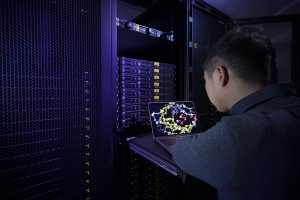
UM researchers can access the HPCC wherever they are
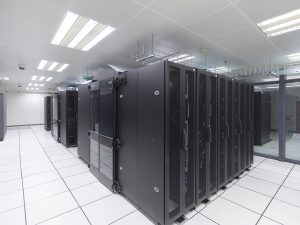
A server room for the HPCC
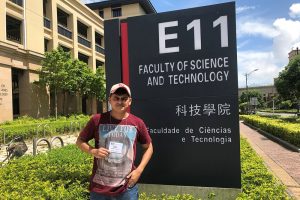
Faraz Mohammadali Shaikh, a PhD student in the Faculty of Science and Technology
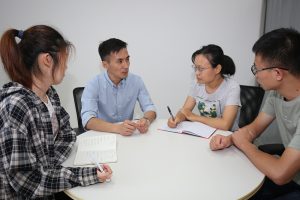
Pan Hui (2nd from left), associate professor of the Institute of Applied Physics and Materials Engineering and head of the Department of Physics and Chemistry, and his postgraduate
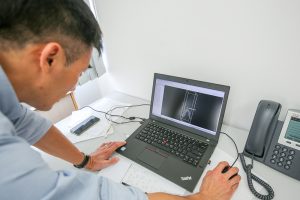
Prof Pan use the HPCC for projects related to new materials

Stanley Seak (centre), head of the Academic Computing and Technology Services Section of the ICTO, and his colleagues
